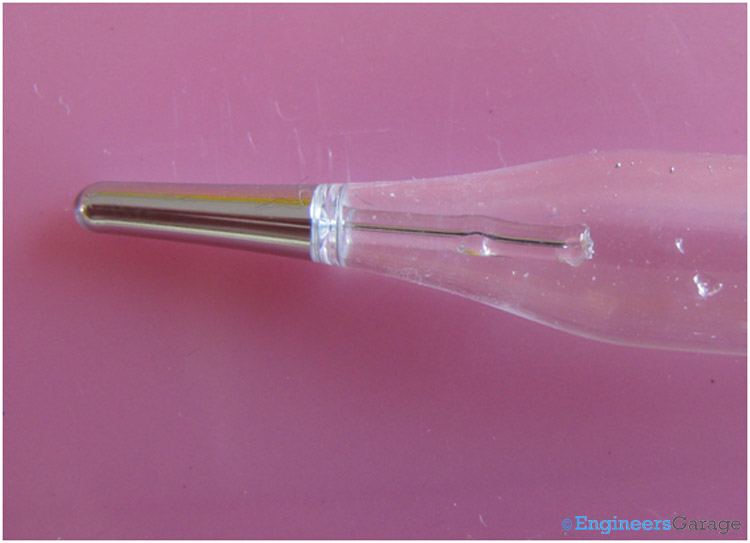A thermometer is an instrument that measures the temperature of a system. The word Analog thermometer refers to mercury thermometers commonly used in homes and clinics to measure body temperatures. The mercury used in thermometer is silvery white in color and in liquid state. Mercury is one of the 92 naturally occurring elements that become liquid at room temperature and remains in liquid state throughout a wide range of temperature.
Fig. 1: Image of Oral/Rectal/Baby Thermometer
Types of Mercury Thermometer
There are basically two types of mercury thermometers that measures body temperature. These are:
• Oral/rectal/baby thermometers, contains about 0.61 grams of mercury; and
• Basal temperature thermometers, contains about 2.25 grams of mercury.
Basal thermometers are ultra sensitive thermometers and they can track body’s minutest temperature shift i.e. they can accurately measure the temperature shift by 0.1 degrees Fahrenheit. On the other hand oral thermometers can measure a minimum temperature shift of 0.2 degrees Fahrenheit. Oral thermometers are used to measure the body temperature at the time of fever while basal thermometers are used by females to chart their basal body temperature to predict their fertile period or ovulation. Basal thermometers can’t be used in the place of oral thermometers because of the high mercury content which is toxic. This article covers the oral thermometer.

Fig. 2: Protection Glass Chamber of Thermometer
The outermost glass casing is called the protection chamber. It is used to protect the internal body parts of thermometer like capillary tube, scale and mercury from coming in contact with the outside world.
Expansion Chamber & Scale

Fig. 3: Expansion Chamber
The top most part of the capillary tube is called the Expansion Chamber. It is hemispherical in shape to provide more space for the gases to expand. When the mercury rises with the increase in temperature in the tube, the gas or air present in the chamber moves upward in the expansion chamber. This space is also utilized by the mercury to expand when the temperature exceeds the value mentioned on the scale. However this condition never arises in normal use.

Fig. 4: Scale of Oral Thermometer Containing both Centigrade and Fahrenheit Reading
Scale is a rectangular piece of thick cardboard with readings of the temperatures printed on it. The capillary tube containing mercury is glued to it. These reading denote the temperature of the body corresponding to the rise in the mercury. The height at which the mercury rests corresponds to calibrated marks on the side scale of the tube, allowing us to read the temperature. This scale may be in oC or oF or in both depending upon the manufacturing companies. The scale divisions are made in accordance with the temperature scale. The normal scale ranges from 35 to 42 oC or 94 to 108 oF.
Capillary Tube

Fig. 5: Capillary Tube of Oral Thermometer
Capillary Tube is a very thin tube of glass having a small diameter. It provides a passage for the mercury to expand. The capillary tube has a different color in comparison to expansion chamber so that human eyes can differentiate between the two and correct reading can be noted easily. Its diameter is same throughout so that distribution of mercury takes place evenly with rise in temperature and accurate reading can be measured.

Fig. 6: Constriction Chamber of Oral Thermometer
Constriction also known as the kink is the narrow part of the thermometer which joins the mercury bulb with the rest of the thermometer. The constriction acts like a ‘valve’ similar to the valve in the heart to prevent the mercury from flowing back. The thermometers should be shaken well before use so that mercury which has been left above in the tube can fall down into the bulb through constriction before taking next reading.
Glass Bulb containing Mercury

Fig. 7: Glass Bulb of Oral Thermometer Containing Mercury
The glass bulb is a reservoir filled with mercury which expands and rises with the rise in temperature. This part of thermometer is made up of stainless steel so that when kept ideal, mercury inside it remains below room temperature. This part of the thermometer makes the contact with the different parts of the human body like arms, tongue etc to measure the body temperature. With the rise in temperature above the room temperature, the mercury expands and starts rising. The mercury thread forces its way through the constriction, crossing it to be trapped after expansion. An accurate reading can still be obtained after it contracts because the constriction has trapped the mercury.

Fig. 8: Mercury Drops in Liquid Form

Fig. 9: A large Mercury Drop formed by Two Drops Coming Together
The above image shows drops of mercury in the liquid form stored in the glass bulb. When two mercury drops come in contact with each other they join to form one drop with a bigger radius. One important thing to be known about mercury is that it is very much harmful for the central nervous system of body. So it should be kept away from the reach of children and must be handled with great care.
Filed Under: Insight


Questions related to this article?
👉Ask and discuss on EDAboard.com and Electro-Tech-Online.com forums.
Tell Us What You Think!!
You must be logged in to post a comment.